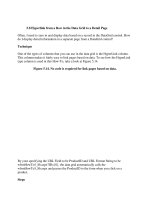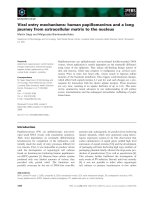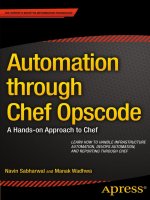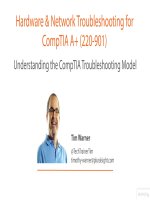IT training building winning algorithmic trading systems a traders journey from data mining to monte carlo simulation to live trading davey 2014 07 21
Bạn đang xem bản rút gọn của tài liệu. Xem và tải ngay bản đầy đủ của tài liệu tại đây (6.02 MB, 284 trang )
BUILDING WINNING
ALGORITHMIC
TRADING SYSTEMS
The Wiley Trading series features books by traders who have survived the market’s
ever changing temperament and have prospered—some by reinventing systems,
others by getting back to basics. Whether a novice trader, professional, or somewhere in between, these books will provide the advice and strategies needed to
prosper today and well into the future. For more on this series, visit our Web site
at www.WileyTrading.com.
Founded in 1807, John Wiley & Sons is the oldest independent publishing company in the United States. With offices in North America, Europe, Australia, and
Asia, Wiley is globally committed to developing and marketing print and electronic
products and services for our customers’ professional and personal knowledge
and understanding.
BUILDING WINNING
ALGORITHMIC
TRADING SYSTEMS
A Trader’s Journey from Data Mining to
Monte Carlo Simulation to Live Trading
Kevin J. Davey
Cover Design: Wiley
Cover Image: © iStockphoto/Emilia_Szymanek
Copyright © 2014 by Kevin J. Davey. All rights reserved.
Published by John Wiley & Sons, Inc., Hoboken, New Jersey.
Published simultaneously in Canada.
No part of this publication may be reproduced, stored in a retrieval system, or transmitted in any form or by
any means, electronic, mechanical, photocopying, recording, scanning, or otherwise, except as permitted under Section 107 or 108 of the 1976 United States Copyright Act, without either the prior written permission
of the Publisher, or authorization through payment of the appropriate per-copy fee to the Copyright Clearance Center, Inc., 222 Rosewood Drive, Danvers, MA 01923, (978) 750-8400, fax (978) 646-8600, or on the
Web at www.copyright.com. Requests to the Publisher for permission should be addressed to the Permissions
Department, John Wiley & Sons, Inc., 111 River Street, Hoboken, NJ 07030, (201) 748-6011,
fax (201) 748-6008, or online at />Limit of Liability/Disclaimer of Warranty: While the publisher and author have used their best efforts in
preparing this book, they make no representations or warranties with respect to the accuracy or completeness
of the contents of this book and specifically disclaim any implied warranties of merchantability or fitness for a
particular purpose. No warranty may be created or extended by sales representatives or written sales materials.
The advice and strategies contained herein may not be suitable for your situation.You should consult with a
professional where appropriate. Neither the publisher nor author shall be liable for any loss of profit or any
other commercial damages, including but not limited to special, incidental, consequential, or other damages.
For general information on our other products and services or for technical support, please contact our
Customer Care Department within the United States at (800) 762-2974, outside the United States at
(317) 572-3993, or fax (317) 572-4002.
Wiley publishes in a variety of print and electronic formats and by print-on-demand. Some material included
with standard print versions of this book may not be included in e-books or in print-on-demand. If this book
refers to media such as a CD or DVD that is not included in the version you purchased, you may download this
material at . For more information about Wiley products, visit www.wiley.com.
Davey, Kevin, 1966Building algorithmic trading systems, + website : a trader’s journey from data mining to Monte Carlo
simulation to live trading / Kevin Davey.
1 online resource. — (Wiley trading)
Includes index.
ISBN 978-1-118-77891-3 (pdf) — ISBN 978-1-118-77888-3 (epub) — ISBN 978-1-118-77898-2 (pbk.)
1. Futures. 2. Portfolio management. 3. Investment analysis. 4. Monte Carlo method.
5. Electronic trading of securities. I. Title.
HG6024.A3
332.64′2028567 — dc23
2014014899
Printed in the United States of America
10
9 8
7 6 5 4
3 2
1
To Amy, Owen, Kathryn, Andrew, and Guardian Angel Anthony—
My love, my children, my life
CONTENTS
Acknowledgments
About the Author
Introduction
ix
xi
1
PART I
A TRADER’S JOURNEY
7
CHAPTER 1
The Birth of a Trader
9
CHAPTER 2
Enough Is Enough
15
CHAPTER 3
World Cup Championship of Futures
Trading® Triumph
23
CHAPTER 4
Making the Leap—Transitioning to Full Time
33
PART II
YOUR TRADING SYSTEM
41
CHAPTER 5
Testing and Evaluating a Trading System
43
CHAPTER 6
Preliminary Analysis
53
CHAPTER 7
Detailed Analysis
61
CHAPTER 8
Designing and Developing Systems
71
PART III
DEVELOPING A STRATEGY
77
CHAPTER 9
Strategy Development—Goals and Objectives
79
CHAPTER 10 Trading Idea
83
vii
CHAPTER 11 Let’s Talk about Data
93
CHAPTER 12 Limited Testing
103
CHAPTER 13 In-Depth Testing/Walk-Forward Analysis
115
CHAPTER 14 Monte Carlo Analysis and Incubation
129
CHAPTER 15 Diversification
133
CHAPTER 16 Position Sizing and Money Management
139
CHAPTER 17 Documenting the Process
147
PART IV
153
CREATING A SYSTEM
CHAPTER 18 Goals, Initial and Walk-Forward Testing
155
CHAPTER 19 Monte Carlo Testing and Incubation
163
PART V
175
CHAPTER 20 Account and Position Sizing
177
CHAPTER 21 Trading Psychology
187
viii
CHAPTER 22 Other Considerations before Going Live
195
CONTENTS
CONSIDERATIONS BEFORE GOING LIVE
PART VI
203
MONITORING A LIVE STRATEGY
CHAPTER 23 The Ins and Outs of Monitoring a Live Strategy
205
CHAPTER 24 Real Time
219
PART VII
233
CAUTIONARY TALES
CHAPTER 25 Delusions of Grandeur
Conclusion
235
243
APPENDIX A Monkey Trading Example, TradeStation Easy
Language Code
247
APPENDIX B Euro Night Strategy, TradeStation Easy
Language Format
255
APPENDIX C Euro Day Strategy, TradeStation Easy
Language Format
259
About the Companion Web Site
263
Index
265
AC K N OW L E D G M E N T S
T
here are many people without whom this book, and my trading career, would
not have been possible. First on the list are my Mom and Dad. They stressed
self‐reliance and taking responsibility for one’s actions. These are great traits for
everyone to have, and they are really critical for traders. I owe my start to them.
Of course, none of my success would have been possible without my great wife,
Amy. Imagine a spouse who fully supported her husband as he walked away from a
great career to become a trader, an endeavor where 90 percent of people fail. Her
support has been 100 percent positive, and I cannot imagine surviving as a trader,
and a person, without it. She is one in a million, and I’m lucky to have found her.
Finally, this book would not be possible without the many traders and wannabe
traders who have contacted me over the years. Realizing my words actually helped
individuals avoid the many unscrupulous people in this industry gives me great joy.
I hope reading this book helps you in the same way.
Happy Trading!
Kevin J. Davey
May 2014
ix
ABOUT THE AUTHOR
K
evin Davey is a professional trader and a top‐performing systems developer. He
generated triple‐digit annual returns 148 percent, 107 percent, and 112 percent
in three consecutive World Cup of Futures Trading Championships® using algorithmic
trading systems. His web site, www.kjtradingsystems.com, provides trading systems,
trading signals, and mentoring. He writes extensively in industry publications such as
Futures Magazine and Active Traderr and was featured as a “Market Master” in the book The
Universal Principles of Successful Trading by Brent Penfold (Wiley, 2010). Active in social
media, he has over 15,000 Twitter followers. An aerospace engineer and MBA by
background, Davey has been an independent trader for over 20 years. Davey continues
to trade full time and develop algorithmic trading strategies.
xi
INTRODUCTION
I
wanted to throw up. The bile in my stomach had reached an unsustainable level,
but there was no bathroom near me. Speeding down the freeway at 75 miles per
hour, with no exit in sight, I’d have to swallow hard and accept my fate. I really
wanted to just curl up and die. Well, not exactly. I wanted to vomit first, then curl
up and die.
Was it trichinosis from eating pork not cooked to shoe leather consistency, as my
Mom always predicted would happen? Nope. An undercooked juicy red hamburger
laced with E. coli? Not exactly. It was meat that was the culprit, but in the form of live
cattle. Live cattle futures, to be exact. Live cattle, all 40,000 pounds of them, had led
to my sudden urge to vomit. Specifically, bovine spongiform encephalopathy, more
commonly known as mad cow disease. I didn’t have the disease, but my ill‐fated
speculative investment did.
This was at the end of December 2003, a month that had started with great personal and professional promise. I recently had been promoted to vice president of
quality assurance at Argo‐Tech, the midsize aerospace firm I was lucky enough to
be part of, before it was bought out by a soulless mammoth corporation. I also had
been honored as a “40 Under 40” recipient from Crain’s Cleveland Businesss magazine—
recognized as one of Cleveland, Ohio’s, up‐and‐coming business stars under the age
of 40. My futures trading account was doing pretty well, to the point where I felt
confident I knew what I was doing (many times that feeling is soon followed by a slap
in the face by the market, but I digress). Finally, my first child was on the way in a
few months. All things considered, I was on a roll.
Then disaster struck. Three times. Quickly.
On December 12, 2003, my beautiful and amazing wife Amy and I had our first
son, Anthony. He was two months premature and was stillborn. The joy of planning
1
INTRODUCTION
2
for the arrival of our firstborn suddenly and tragically became planning for a funeral and burial. It is nearly impossible to understand the gut‐wrenching pain that
comes with losing a child, until it happens to you. I certainly was not prepared for it.
Dreams were destroyed that day, life suddenly became unfair, hope and joy seemed
a distant memory. Needless to say, Amy and I were both mentally, physically, and
emotionally devastated.
Less than a week later, on December 17, the second calamity hit. My father passed
away on his 75th birthday. Ironically, after three open‐heart bypass surgeries over the
previous 30 years, it was not his clogged arteries that got him, but cancer—a nasty
cancer that is common to chimney sweepers. That made sense, I suppose, since he
was a firefighter, and in his prime chased many raccoons out of chimneys, as the co‐
owner of a pest control company. After watching him lying in bed while life slowly
left his body, my head began spinning like a top. To say I could not think straight was
an understatement.
With two such life‐changing events within a week, you probably would guess that
I would not be trading or taking up any other type of mental and emotional task.
But you’d be wrong. I was still trading. Looking back on it now, I was completely
crazy to trade.Yet I did. On December 23, about an hour or so before the close, on a
whim I decided that I should buy live cattle futures. I’m sure I had my reasons, but I
am equally sure that those reasons were contrived by my mind in order to justify the
trade. I wasn’t in my right mind at all. I had no business trading.
I’m sure you know how this story ends. After the close on December 23, the U.S.
Department of Agriculture announced that a case of mad cow disease was found in
the United States. The impact on the market would be terribly negative. Since I was
long cattle futures, and the market was certainly headed for a free fall, my account
was in for a slow death, temporarily slowed only by the daily limits in the futures
markets. I could only lose $600 per day per contract, at least until the exchange ex-
Mad cow disease
announced after the
close
FIGURE 0.1 Mad Cow Disease Causes Live Cattle Futures to Collapse
panded the daily downside limit. For my account size, having a “locked limit” down
even with one contract was extremely painful.
A week later, after three days of a locked limit down market—where I could not
exit at any price—I was finally able to liquidate, with a $5,400 loss.
This was about seven times the maximum loss I had expected, and as a percentage
of my account, it was brutal. Not the end of the world, but it really made me wonder.
Was the past month just the start of a prolonged losing streak, both in trading and in
life? What was I doing trading anyhow, after all the recent emotional hits to my psyche?
And trading on a whim, a hunch? When was I going to stop such destructive behavior?
Could I stop such destructive behavior and finally turn into a winning trader? Could
this series of unfortunate events provide the impetus to rise from the ashes, to turn my
trading around? So many questions—ones I had no answer for.
As it turns out, as bad as this trade was, mad cow disease probably saved my trading life. This book documents that trading story, warts and all. Along the way, I got
better and better at developing mechanical trading systems, and later in the book I
show you the process I use to develop winning algorithmic trading systems.
■ Who Can Benefit from This Book?
3
INTRODUCTION
Regardless of the type of trader you are, or your experience level with trading, I
think you’ll find something in this book that resonates for you.
For beginner traders, I hope this book is an eye‐opener for you. I can’t, and I
won’t, fill your head with thoughts of trading profits raining down from the sky.
Anyone who tells you trading is easy is flat‐out lying to you. Sure, you can make
lots of money trading, but you also need to be prepared for a lot of losing, a lot of
drawdowns, and a lot of risk. Whenever someone tells me trading is a piece of cake,
I always suspect that they are half‐baked. My story, as painful as it is at times, is a
realistic journey for many retail traders. Of course, as I tell all beginners, read what
I have written, but then read books by other traders, too. Keep an open mind to
everything. After a lot of reading, you’ll be able to make solid judgment calls on what
is correct, what is BS, and what you like and don’t like. The amount of misinformation about trading is staggering, so all beginners must be wary.
For intermediate or slightly experienced but struggling traders, maybe your
failures up until this point aren’t a result of psychology or confidence. Many
trading books nowadays put a lot of emphasis on the mental aspect, but all the
mental preparation in the world won’t help you if you are developing strategies
incorrectly. If you’ve ever lost money after you started trading a strategy right
after optimizing it, then you probably realize you were doing something wrong.
The process detailed in this book should be right up your alley, since it will steer
you in the right direction.
INTRODUCTION
4
For expert traders, most of what I present here you’ll have already seen before in
some fashion. Certainly, there are many great trading books that discuss many of the
issues and problems that I address here. But there is always something new to learn, a
different approach to try, and a different way to think.You probably find many items
in this book that are different from your current method, and you’ll likely benefit
from incorporating these new ideas in your trading.
Although the book is designed around algorithmic or mechanical trading, which
is what I primarily do, discretionary traders can benefit from the concepts detailed
in this book. Maybe there are parts of your discretionary approach that can be statistically tested. For example, let’s say your discretionary entry consists of a moving
average crossover, combined with your intuition. It might be impossible to test your
intuition, but a moving average crossover can be walk‐forward tested and gently
optimized. Or perhaps you want to evaluate breakeven or moving stops for your
exit. There are many wrong ways to test this, but only a few correct ways. You’ll
learn a correct way in this book. Therefore, utilizing the concepts in this book, you
can improve your discretionary approach a great deal, all because you’ll know how
to properly design and test a trading system. Whether it is a 100 percent mechanical
strategy, or a part mechanical and part discretionary system, putting actual performance numbers to entries and exits can only give you confidence and make for a
better trading approach.
I have organized BuildingWinning Algorithmic Trading Systems into seven parts. In all
seven sections of the book, you’ll see me use certain terms interchangeably:
Strategy or trading system—the approach used to trade. This can be rigid rules,
general guidelines and principles, or flat‐out random guessing. The net result is
your strategy or trading system.
Mechanical or rule‐based trading or algorithmic trading—a style of trading in which all
the rules are defined 100 percent. There is no discretion involved, no decisions
to be made by the trader.
Hybrid or mixed trading system—a style of trading that includes aspects of algorithmic trading, along with discretionary trading. An example would be a mechanical system that gives entry and exit signals, but gives the trader the option to
accept or reject the signal.
In Part I, I walk you through my trading history. I think my early ups and downs—
mostly downs—are pretty typical of new or beginning traders. I paid “tuition”
to the market for many years. But I was able to persevere, winning the World Cup
Championship of Futures Trading® in 2006, and finishing second in 2005 and 2007.
After those successes, I reached the point all part‐time, hobby shop, retail traders
dream of: I was able to leave a promising career and live the dream of trading full time.
In the second part of this book, I tell you how I currently do things. From evaluating trading systems to designing new trading systems, I lay out my process. It is not
perfect, and it is ever evolving, but it contains crucial information that I wish I had
when I started out. Even if you just follow bits and pieces of what I do, you should
be able to save thousands in market tuition.
In Parts III‐VII, I build a trading system, from concept to live trading. It is a good
trading system, but by no means the Holy Grail (which, by the way, does not exist). I
also discuss in this section what I think is the closest one can get to the Holy Grail—
diversification. Finally, I discuss how I monitor my strategies in real time, with a
real‐time diary of my trading progress through a number of months.
I hope that by reading my story, you’ll be able to avoid my mistakes and learn from
them. Trust me because, as you’ll see, I’ve made a ton of them.
5
INTRODUCTION
PA R T I
A Trader’s
Journey
CHAPTER 1
The Birth of
a Trader
I
t was 1989, and I was California dreamin’. Actually I wasn’t dreaming, I was already in California, living a young single man’s dream. A year or so out of college,
I was residing in sunny Manhattan Beach, California, with a small apartment three
blocks from the soft white sand so wonderful that they used it to help create Waikiki
Beach in Hawaii. I had graduated the year before, summa cum laude, with a bachelor’s degree in aerospace engineering from the University of Michigan, a top‐tier
engineering school. Then I had turned my back on Massachusetts Institute of Technology (MIT), California Institute of Technology (Cal Tech), Stanford University,
Purdue University, and Michigan, all of whom had accepted me in their aerospace
master’s degree program. I turned down those great schools to live and work in
sunny California, a lifelong dream.
I still remember the precise moment I made that fateful decision. On a bitterly
cold winter’s day in Ann Arbor, Michigan, I was walking down South University
Avenue to one of my final‐semester classes. The wind was blowing so hard in my face
that I actually leaned into the wind to see if it would keep me up. At that point, falling face‐first onto the ice‐covered sidewalk would not have been much worse than
feeling the stinging wind in my face. What seemed like a gale‐force wind kept me
upright, and then I knew—I did not want, or need, to live where it was cold in the
winter when aerospace engineering graduates like me were flocking to jobs in sunny
southern California. My mind was made up. Sun and sand it was.
A few weeks after graduation, I packed up my belongings, and with my sister
Karen as my driving companion, drove cross‐country to warm and sunny Los
Angeles.
9
THE BIRTH OF A TRADER
10
One year later, I was settled in. I had a close group of friends, most of them
Midwestern transplants like me. We’d while away the weekends playing beach
volleyball, usually capping the day off with a few drinks at a local pub. I loved beach
living and all the entertainment it provided. Driving around the beach cities in my
little red T‐roof sports car, life was pretty good.
But something was missing.
I couldn’t put my finger on it, but I knew this wasn’t the life for me. Well, beach
life certainly agreed with me, but my choice of career was the wrong one. Sure,
designing future fighter airplanes and working on secret government projects was
fulfilling to a degree. But I just didn’t feel like it was my future. I could not see myself doing that kind of work for even 5 years, much less a career of 30 or 40 years. I
needed a jolt to wake me up. That jolt came in the form of junk mail that appeared
in my mailbox one day, and it changed everything.
The junk mail booklet was from Ken Roberts, a futures and commodities trader.
Or at least that is how he presented himself. Looking back on it, he was definitely
more of a salesman than a trader.With a nice, folksy smile and a cowboy hat, Ken laid
out the riches that awaited anyone brave enough to trade futures, or commodities, as
they were more commonly referred to back then.
He had a compelling story in that little booklet of his, and I’ll admit I was quickly
hooked. Looking at a chart of sugar, as shown in Figure 1.1, seeing all the potential
profit just waiting for me, how could I not be?
At that point, words like drawdown, risk of ruin, and emotional controll were not in my
vocabulary. But massive profits, easy money, and simple trading suddenly were! And with
a money‐back guarantee, how could I go wrong? It was a risk‐free entry pass into a
world of unlimited profit potential—or so my naive self‐thought. So I sent a check
and dreamed that night about all the riches that would soon be flowing my way.
A few weeks later, I received the full trading course. It was a hefty manual, full of
charts with profitable examples. Initially, I was duly impressed. But then I started to
46-point rise in sugar
in 5 months =
$51,520 profit per
contract
FIGURE 1.1 Sugar Skyrocketing = Unlimited Profits?
Head
Shoulder
Shoulder
Signal to sell
short
FIGURE 1.2 Good Head and Shoulders Pattern or Just a False Signal?
11
THE BIRTH OF A TRADER
look a little closer at the details. Turns out the whole course was primarily based on
the 1‐2‐3 head and shoulders pattern. As most traders and investors know, this pattern is a classic chart pattern, as shown in Figure 1.2. It is easy to find on just about
any chart you look at—you can find a profitable example or two on most any chart,
any instrument, and any time frame.
The problem is that the head and shoulders pattern gives a lot of false signals and
usually looks good only in hindsight. Of course, I did not know that at first. I only
knew I could look at a chart, pick out the head and shoulders pattern, and see how
well it worked.
I eventually found out I was missing two key pieces of the puzzle. First, when you
look at a chart with a head and shoulders or any other pattern in it, it is easy to see
the winning trades because you are looking at both the pattern and the outcome of
that pattern. If you try hiding the outcome of a pattern, it becomes much more difficult to find the good patterns.
The second key I was missing is that the existence of a pattern, by itself, doesn’t
necessarily mean a trade should be taken. If you take every single head and shoulders
trade you see, you will soon be broke, as shown in Figure 1.3. Of course, the naive
wannabe trader in me was oblivious to this fact.
After a month of dutifully following and paper trading all the head and shoulders
signals, and finding most of them to be unprofitable, I sent all my trading records, along
with the manual, back for a refund.True to his word, Mr. Roberts refunded my money.
My dream of trading riches was shattered, at least temporarily. On the bright side,
I now saw futures as the way to go—I just realized head and shoulders patterns were
not going to be the way. Once I abandoned the get‐rich‐quick idea with the 1‐2‐3
head and shoulders patterns, I did what many scientific, numbers‐oriented people
do: I looked to mathematical formulas to help me in my decision making. And I
started where many people do: moving averages.









